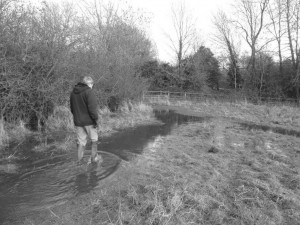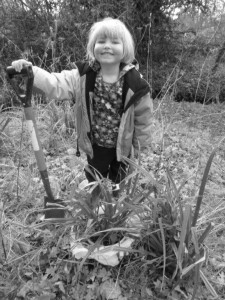The last working party of the year in early December was on a mild sunny perfect winter day, a last chance to tidy up before the serious winter weather arrives. Most of the tasks are never ending like litter picking and mending fences. The ford itself seems alive, as it changes from day to day bringing silt, twigs and branches and even moving large stones on stormy days. We saw a heron hoping to catch a frog, and a moorhen searching among twigs on the waterfall. Then it rained and rained and by mid January it’s still raining but no hard frost or very cold weather. However this is very good news for all worm eating wildlife; because earthworms breathe through their skin, they have to come up to the surface when it rains or risk drowning. Earthworms are an important source of protein, particularly in winter; the blackbird is probably the best known earthworm eater, because it is such a regular garden visitor.
Watch other birds too: robins, song thrushes and even kestrels and tawny owls can also be seen feeding on earthworms. Many small mammals feast on them, moles eat little else, and hedgehogs love them. Foxes will eat many worms when there is little prey but earthworms provide the badger with 60% of its food. Earthworms together with fungi are nature’s most efficient and important recyclers. They eat their way through the soil, digesting any decaying organic matter and, in doing so, release minerals that plants can use. Famously hermaphroditic, earthworms are both male and female in one body, though it still takes two worms to reproduce. Charles Darwin called worms “the most important animal on the earth” while in ancient times Aristotle called them “the intestines of the soil”.

The house spider tries to stay indoors at this time of the year; there is no point in killing it, as it does an excellent job of destroying flies. It spins a large web, up to 300mm across, and sits in a tubular retreat in the corner. When it feels the vibrations of a trapped fly it hurries out, poisons its victim and eats it at leisure. In medieval times, a house spider was thought to be a good remedy for malaria, “gently bruised and wrapped in a raisin or spread on bread and butter” and a butter wrapped spider was thought to cure the plague and leprosy. The larger cardinal spider is supposed to have been named for frightening Cardinal Wolsey at Hampton Court.

As the years go by it gets more and more difficult to think of something new for the Christmas tree festival at the Methodist Church. As usual our small team rose to the challenge and were very successful – thanks to everyone who voted for us. The birds and animals have eaten most of the autumn berries but the beautiful black ivy berries should be ready in February and will attract song thrushes, robins, fieldfares, starlings and blackbirds. As with yew berries the seeds inside ivy berries are poisonous, but they too pass through birds’ intestines and are scattered in their droppings; with luck some will fall at the foot of a wall or tree, which will offer support for the seedlings that grow from them. Look out for signs of spring at Canley Ford, we saw yellow catkins, cuckoopints and snowdrops pushing up through the earth and woodpeckers and other birds calling to attract a mate.
The next working party will be on Saturday 1 March, 10am – 12noon.
Friends of Canley Ford
